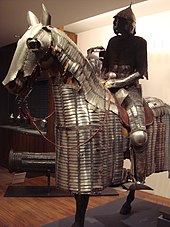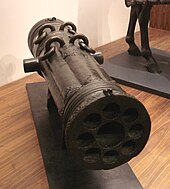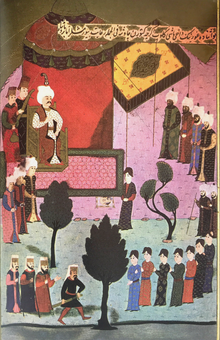Ottoman–Mamluk War (1516–1517)
| Ottoman-Mamluk War (1516–1517) | |||||||||
|---|---|---|---|---|---|---|---|---|---|
| Part of the Ottoman wars in the Near East | |||||||||
 News pamphlet relating the Ottoman–Mamluk War (1516–1517), including an account of Sultan Selim's visit to Jerusalem. Printed in Basel, dated 1518 | |||||||||
| |||||||||
| Belligerents | |||||||||
|
| |||||||||
| Commanders and leaders | |||||||||
The Ottoman–Mamluk War of 1516–1517 was the second major conflict between the Egypt-based Mamluk Sultanate and the Ottoman Empire, which led to the fall of the Mamluk Sultanate and the incorporation of the Levant, Egypt, and the Hejaz as provinces of the Ottoman Empire.[1] The war transformed the Ottoman Empire from a realm at the margins of the Islamic world, mainly located in Anatolia and the Balkans, to a huge empire encompassing much of the traditional lands of Islam, including the cities of Mecca, Cairo, Damascus, and Aleppo. Despite this expansion, the seat of the empire's political power remained in Constantinople.[2]
Background
[edit]The relationship between the Ottomans and the Mamluks had been adversarial since the Fall of Constantinople to the Ottomans in 1453; both states vied for control of the spice trade, and the Ottomans aspired to eventually take control of the Holy Cities of Islam.[3] An earlier conflict, which lasted from 1485 to 1491, had led to a stalemate. Having vanquished the Safavid Persians at the Battle of Chaldiran in 1514, sultan Selim I was eager to conquer the Mamluk Sultanate, which ruled in Syria and Egypt.[2] Thus freed of other concerns, by 1516, the Ottoman Empire turned its full might against the Mamluks to complete the Ottoman conquest of the Middle East.[2]
Sultan Selim alleged that the Mamluks were Muslim oppressors and that they were allied with the Shia Safavids. Based on these accusations, a fatwa appeared, stating: “Whoever helps people who are misled, he is also a heretic."[4]
The Mamluks drafted farmers and peasants from rural areas as soldiers for their upcoming war with the Ottomans. In response, these men fled to avoid being drafted. This led to shortages in rural workers required for food production and a shortage of bread, resulting in a near famine that devastated towns from Cairo to Anatolia.[5]
Both the Ottomans and Mamluks assembled 60,000 soldiers.[clarification needed] However, only 15,000 Mamluk soldiers were trained warriors: the rest were mere conscripts who did not even know how to fire a musket. As a result, most of the Mamluks fled, avoided the front lines, and even committed suicide. In addition, as had happened with the Safavids in the Battle of Chaldiran, the blasts of the Ottoman cannons and guns scared the Mamluk horses, which raced uncontrollably in every direction.[clarification needed][5]
Operations
[edit]
The war consisted of several battles. The Mamluk army was rather traditional, mainly consisting of cavalry using bows and arrows, whereas the Ottoman army, and especially the Janissaries, was quite modern, using arquebuses.[6] The Mamluks remained proud in their tradition and tended to disdain the usage of firearms.[7][8]
Operations in the Levant (1516)
[edit]The Ottomans first captured the city of Diyarbekir in southeastern Anatolia.[2] The Battle of Marj Dabiq (24 August) was decisive, and the Mamluk ruler Kansuh al-Ghuri was killed.[2] The Ottomans apparently outnumbered the Mamluks by a factor of 3 to 1.[8] Syria fell under the rule of the Ottomans with this single battle.[8]
The Battle of Yaunis Khan occurred near Gaza (28 October) and was again a defeat for the Mamluks.
Operations in Egypt (1517)
[edit]
Al-Ghuri's successor as Mamluk sultan, Tuman Bay, frantically recruited troops from various classes of society and Bedouins, and attempted to equip his armies with some quantity of cannons and firearms, but all at the last minute and on a limited scale.[7][8] Finally, at the doorstep of Cairo, the Battle of Ridaniya (24 January) took place, in which the Ottoman commander Hadım Sinan Pasha lost his life.[9] In this battle, Selim I and Tuman Bay faced each other. The firearms and guns deployed by Tuman Bay turned out to be almost useless, as the Ottomans managed an attack from the rear.[8]
The campaign had been supported by a fleet of about 100 ships that supplied the troops during their campaign to the south.[10]
A few days later, the Ottomans captured and sacked Cairo,[8] capturing Caliph Al-Mutawakkil III.[11] Tuman Bay regrouped his troops in Giza, where he was finally captured and hanged at the gate of Cairo.[2][12]
Operations in the Red Sea (1517)
[edit]The Ottoman fleet of Selman Reis was already stationed in the Red Sea by 1517. Fearing Portuguese fleets the blockade on Bab Al Mandab to continue.[clarification needed] Selman's fleets aimed to clash with the Portuguese to free the trade route with India and to protect the holy land of Hejaz. Despite the ongoing war with the Mamluks, the Ottomans defended Jeddah in December 1517, the last garrison of the Mamluk regime.
While Jeddah became a direct Beylerbeylik to the Ottoman Empire, eight years later, the Sharif of Mecca, Barakat ibn Muhammad, also submitted to the Ottomans, placing the holy cities of Mecca and Medina under Ottoman rule as a vassal state.[2][13]
Consequently, Ottoman power was extended as far as the southern reaches of the Red Sea, although control of Yemen remained partial and sporadic.[2]
Consequences
[edit]
Mamluk culture and social organization persisted at a regional level, and the hiring and education of Mamluk "slave" soldiers continued, but the ruler of Egypt was an Ottoman governor protected by an Ottoman militia.[2][14] The fall of the Mamluk Sultanate effectively put an end to the Portuguese–Mamluk naval war, but the Ottomans then took over the attempts to stop Portuguese expansion in the Indian Ocean.
The conquest of the Mamluk Empire also opened up the territories of Africa to the Ottomans. During the 16th century, Ottoman power expanded further west of Cairo, along the coasts of northern Africa. The corsair Hayreddin Barbarossa established a base in Algeria, and later accomplished the Conquest of Tunis in 1534.[2]
Following his capture in Cairo, Caliph Al-Mutawakkil III was brought to Constantinople, where later tradition claims he ceded his office as caliph to the Ottomans.[12] This established the Ottoman Caliphate, with the sultan as its head, thus transferring religious authority from Cairo to the Ottoman throne.[11]
Cairo remained in Ottoman hands until the 1798 French conquest of Egypt, when Napoleon I claimed to eliminate the Mamluks.[15]
The conquest of the Mamluks was the largest military venture any Ottoman Sultan had ever attempted. In addition, the conquest put the Ottomans in control of two of the largest cities in the world at the time- Constantinople and Cairo. Not since the height of the Roman Empire had the Black, Red, Caspian, and Mediterranean seas been governed by a single empire.[5]
The conquest of Egypt proved extremely profitable for the empire as it produced more tax revenue than any other Ottoman territory and supplied about 100% of all food consumed. However, Mecca and Medina were the most important of all the cities conquered since it officially made Selim and his descendants the Caliphs of the entire Muslim world until the early 20th century.[5]
See also
[edit]- Ottoman–Mamluk War (1485–1491)
- Ottoman wars in Africa
- Ottoman wars in the Near East
- History of Ottoman Egypt
References
[edit]- ^ Tony Jaques (2006). Dictionary of Battles and Sieges. Greenwood Press. p. xxxiv. ISBN 9780313335365.
- ^ a b c d e f g h i j Saraiya Faroqhi (2009). The Ottoman Empire: A Short History. Markus Wiener Publishers. pp. 60ff. ISBN 9781558764491.
- ^ Palmira Johnson Brummett (1994). Ottoman seapower and Levantine diplomacy in the age of discovery. SUNY Press. pp. 52ff. ISBN 9780791417027.
- ^ Firdaus, Yelmi Eri, Elfia Elfia, and Meirison Meirison. "RISE AND FALL OF MAMLUK SULTANATE: The Struggle Against Mongols and Crusaders in Holy War." Al-Adyan: Journal of Religious Studies 1, no. 1 (2020): 14-28.
- ^ a b c d Mikhail, Alan (2020). God's Shadow: Sultan Selim, His Ottoman Empire, and the Making of the Modern World. Liveright. ISBN 978-1631492396.
- ^ Joan D. Barghusen; Bob Moulder (2001). Daily Life in Ancient and Modern Cairo. Lerner Publications. p. 41. ISBN 9780822532217.
- ^ a b Kenneth Chase (2003). Firearms: A Global History to 1700. Cambridge University Press. p. 104. ISBN 9780521822749.
- ^ a b c d e f M. W. Daly; Carl F. Petry (1998). The Cambridge History of Egypt. Cambridge University Press. pp. 498ff. ISBN 9780521471374.
- ^ Martijn Theodoor Houtsma (1987). E. J. Brill's First Encyclopaedia of Islam, 1913–1936. BRILL. p. 432. ISBN 9789004082656.
- ^ Palmira Johnson Brummett (1994). Ottoman Seapower and Levantine Diplomacy in the age of discovery. SUNY Press. p. 110. ISBN 9780791417010.
- ^ a b Drews, Robert (August 2011). "Chapter Thirty – The Ottoman Empire, Judaism, and Eastern Europe to 1648" (PDF). Coursebook: Judaism, Christianity and Islam, to the Beginnings of Modern Civilization. Vanderbilt University.
- ^ a b Muir, William (1896). The Mameluke; Or, Slave Dynasty of Egypt, 1260–1517, A. D. Smith, Elder. pp. 207–213.
- ^ "The Emirs of Mecca and The Ottoman Government of Hijaz 1840 1908 Mekke Emirleri Ve Hicazda Osmanli Idaresi 1840 1908". Scribd. Retrieved 16 September 2021.
- ^ Caroline Williams (2008). Islamic Monuments in Cairo: The Practical Guide. American University in Cairo Press. p. 6. ISBN 9789774162053.
- ^ André Raymond (2000). Cairo. Harvard University Press. p. 189. ISBN 9780674003163.
- Invasions by the Ottoman Empire
- Invasions of Egypt
- Invasions of Syria
- Invasions of Lebanon
- Invasions of Israel
- Egypt–Turkey relations
- Wars involving the Mamluk Sultanate
- History of the Ottoman Empire in Asia
- 1516 in the Ottoman Empire
- 1517 in the Ottoman Empire
- 1516 in the Mamluk Sultanate
- 1517 in the Mamluk Sultanate
- Conflicts in 1516
- Conflicts in 1517
